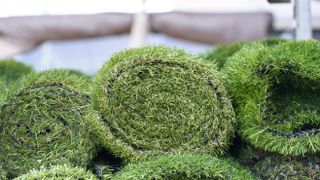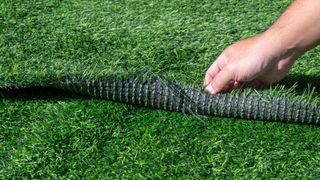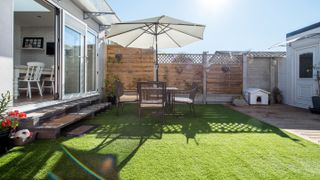7 mistakes to avoid when using artificial turf to make your back yard more attractive
Why your artificial turf lawn doesn’t look quite right

Grass lawns can be a great use of backyard space, but they also require a lot of maintenance. Between watering, weeding and everything in between, you can end up sinking a lot of time and money into keeping your garden looking green and orderly. For some, this may be an enjoyable way to spend time, but it’s not for everyone.
Instead, many choose to lay down artificial turf to achieve that same green look and soft feel, yet without all the extra labor of taking care of living plants. While it won’t look quite the same, it can still be a very compelling option — when installed properly.
Today’s artificial turf is much higher in quality and style than in previous years. It’s possible to buy turf that looks convincing and feels good on the skin, instead of appearing fake and plasticky. The differentiating factor will be how you lay it down. It’s possible to simply lay the rolls of turf on top of existing mowed grass, but this will cause you problems in the long term.
In fact, there are several key mistakes that gardeners often make when turfing their lawn, all of which can undermine your lovely green canvas. Avoid these mistakes and you can ensure that your garden will look as close to the real thing as possible, day after day.
1. You get “face weight” and “total weight” mixed up

Always check the product labeling to ensure that you’re making your turf choice based on the correct figure, the face weight.
Before buying your turf, you’ll need to select the right product for your yard. Different turfs will vary in color and thickness, which will greatly impact the final effect. But it’s not just about finding the right shade of green. What you need to look for is a high face weight, as this refers to the amount of artificial yarn fibers on the surface layer.
Higher face weights are denser, softer and look more realistic, which is what most people want from their turf lawn. However, the product may also list its total weight, which includes not just the artificial fibers but also the various backing materials attached to the turf. This number will always be higher than the face weight and can distract you from a lower-than-desired fiber count. It is easy to confuse the face weight and the total weight if you don’t read the labeling closely, which can lead you to spend money on a product that you think is higher quality than it is.
2. You don’t order sufficient turf at once

Once you’re ready to make your choice of turf, buy enough to cover your whole yard. If in doubt, opt for a little more than you need, rather than less.
Before buying your turf, you’ll need to select the right product for your yard. Different turfs will vary in color and thickness, which will greatly impact the final effect. But it’s not just about finding the right shade of green. What you need to look for is a high face weight, as this refers to the amount of artificial yarn fibers on the surface layer.
Sign up to get the BEST of Tom’s Guide direct to your inbox.
Upgrade your life with a daily dose of the biggest tech news, lifestyle hacks and our curated analysis. Be the first to know about cutting-edge gadgets and the hottest deals.
Higher face weights are denser, softer and look more realistic, which is what most people want from their turf lawn. However, the product may also list its total weight, which includes not just the artificial fibers but also the various backing materials attached to the turf. This number will always be higher than the face weight and can distract you from a lower-than-desired fiber count.
It is easy to confuse the face weight and the total weight if you don’t read the labeling closely, which can lead you to spend money on a product that you think is higher quality than it is.
3. You don’t prep the ground appropriately

Remove grass, debris and the top layer of soil from the yard so that you can create a smooth, compact base on which to lay your turf.
Just because the turf is artificial, that doesn’t mean you can just lay it on the ground with no prep work. It can be tempting to simply cut the grass short and place the turf rolls on top, but this will cause problems. If the ground has any uneven surfaces or bumps, this will distort the turf and create visual disruption from the beginning. If there isn’t good drainage then you could easily collect pools of water that will damage the turf over time.
It’s important to first clear the area of grass and rid the ground of any stones, weeds and other debris. Then, you’ll need to remove the top layers of soil so that you have room for your turf base; if you don’t do this, the turf will be raised higher than the rest of the yard. Installing a turf base, usually made from a mix of gravel, stone or crushed rock, promotes sufficient draining so that the turf doesn’t collect water and develop mold. If possible, compact the ground before installing the base, so that you can create an even smoother surface. Lastly, water the ground to further compact the materials and test the drainage.
Aimerla Foldable Garden Kneeler: $59 @ Walmart
Gardening can often be a strain on the knees, but this convenient garden kneeler and seat set is ideal for protecting knees from the hard ground, ensuring comfort when doing those garden chores. Designed to be sturdy, this foldable garden kneeler also doubles up as a stool and comes with a snap-lock that ensures it stays shut to support up to 350 pounds. Its stainless steel frame is also rust-resistant to cope with the elements.
4. You forget the weed barrier

Always take the extra step to install a weed preventing membrane on top of the soil, to minimize any chance of weeds penetrating up through the artificial turf.
Once the ground has been prepped, it’s tempting to skip right to your turf base and artificial grass. Yet even if you’ve done a good job with the prep work and removed all visible weeds, there is still a chance that weeds will spread from elsewhere and begin to grow up through that underlying soil base. This growth can try to break through the turf, causing distortion and possibly damage to your artificial lawn.
While you can’t eliminate any and all traces of weeds, you can lay down a protective membrane that will restrict any weed growth from penetrating through and harming the turf. These plastic membranes lie on top of the ground and underneath the turf base, adding almost no extra height or bulk but ensuring a smooth upper surface.
5. You don’t lay the grass in the same direction

Align all the rolls of turf so that the fibers are angled in the same direction, to create a more uniform and convincing appearance.
Artificial turf will never look quite like authentic grass, in part because real grass is varied and disorderly while turf is uniform. Rolls of turf feature fibers that all face in one direction, with little differentiation between them. This is because, much like carpets, artificial turf has a pile. However, you can help to make the turf look more believable, simply by how you lay it down.
While some products will have fibers that stand entirely straight, most will lean at a slight angle – an angle that will become very visible if the rolls face in different directions. This won’t just look a bit messy but will be visually jarring, making it clear that you’re using a fake material from a single glance.
To help make your grass look as close to real as possible, it’s important to make sure that each roll of turf faces in the same direction. If possible, angle the fibers so that they face towards the house so that you look into the pile; this looks more convincing.
6. You utilize straight seams instead of S-seams

Use S-shaped seams, not straight seams, to get rid of any unsightly lines between your rolls of turf. This will make the lawn look more real.
Turf comes in rolls, which will almost definitely be too narrow to fully cover an area. You will need to line up the rolls next to each other to ensure that all of the ground is turfed properly, but this can create very obvious lines if the seams are straight. These lines make the lawn look less convincing and real, which is why you want to avoid them.
The most effective way to avoid straight seams is to create a new seam, one in a curved S shape. The turf rolls will not perfectly line up against each other but will instead overlap in places, creating a much more organic, imperfect look. If you are cutting these seams yourself, you should do so before you lay the turf down as you want there to be minimal movement and disruption once the turf is in place; this can drag the soil, create uneven surfaces and undermine all your good preparatory work.
7. You throw out the extra scraps

Store any remaining scraps of turf so that you can use them to plug gaps and make repairs, should your turf get damaged.
If you’ve avoided all these mistakes, you will have bought the right amount of turf to cover your entire backyard in one go and then likely trimmed it to create S-shaped seams. This will result in scraps of extra artificial turf, in addition to any remaining strips from the rolls of turf. It might be tempting to throw these out and save yourself the storage space, especially if you’ve done a good job laying down the turf so it looks pristine. After all, artificial turf is meant to hold up without much upkeep, so why plan for a rainy day?
Still, you’d be wiser to keep these materials on hand for the future. The best way to patch up an artificial lawn is to use the very same turf — which may no longer be available when the damage is finally done. Don’t leave yourself having to track down the same product or a close-enough competitor, before you can make any fixes. Awkwardly shaped scraps are the most resourceful way to plug any gaps or fill in any weathered areas, extending the life of your lawn and saving you money.
More from Tom's Guide
Madeleine Streets is a writer and content manager based in New York City. She covers an eclectic mix of lifestyle, technology, finance and health and has been published in Tom's Guide, Women's Wear Daily, SELF, Observer, Footwear News and others. Originally from London, Madeleine has a penchant for tea, baking and moody weather. When she’s not writing, you can find her exploring the city’s bookstores, hunting down new restaurants, fostering cats and cheering on Arsenal FC.

